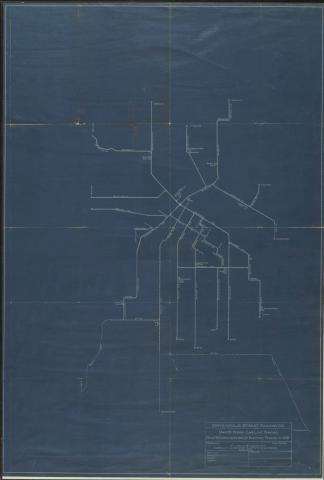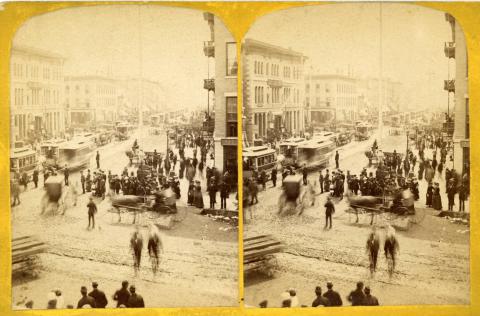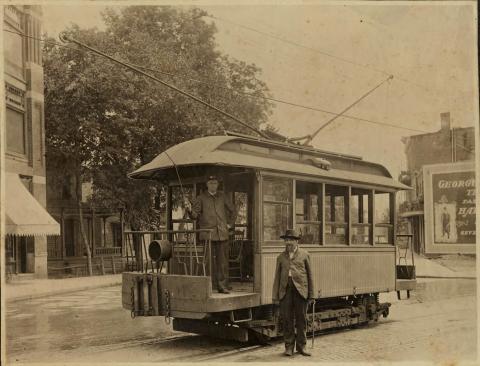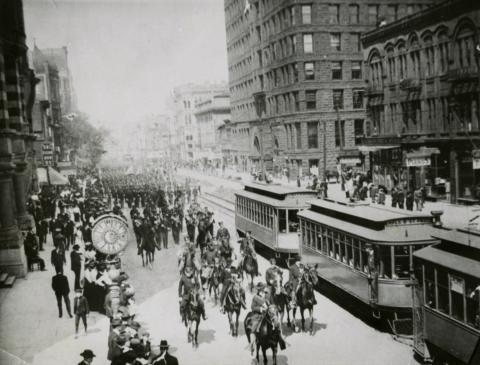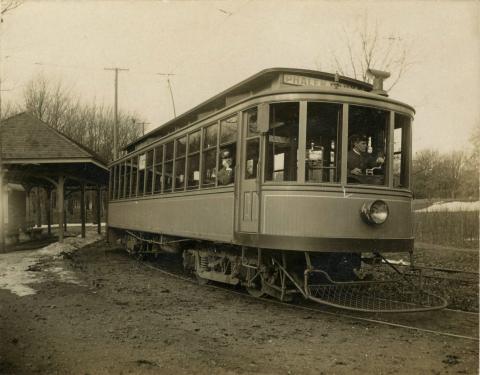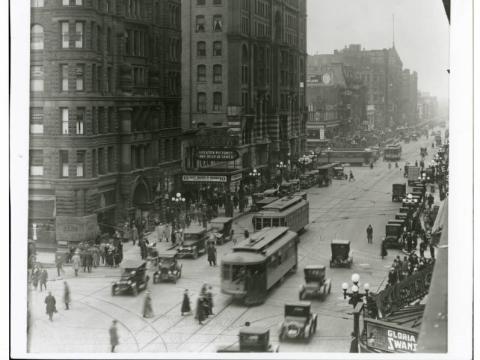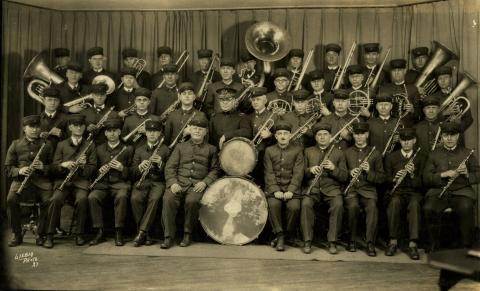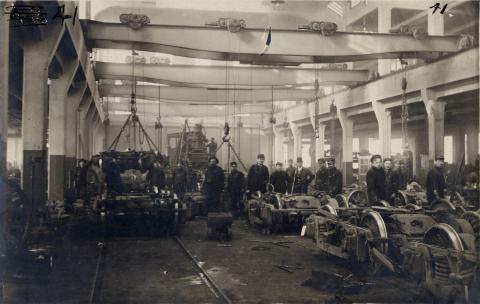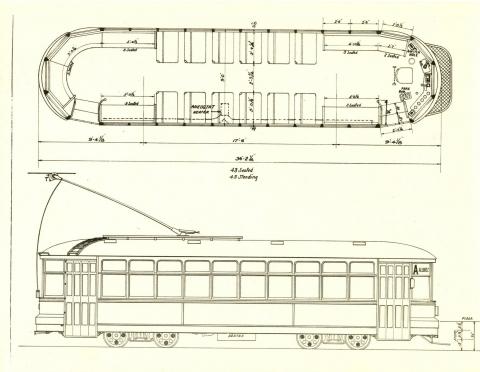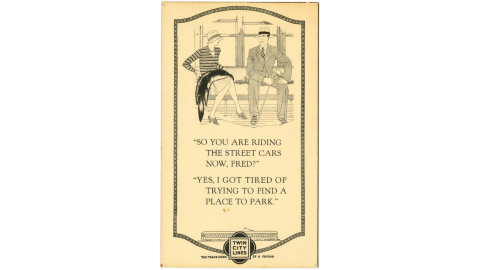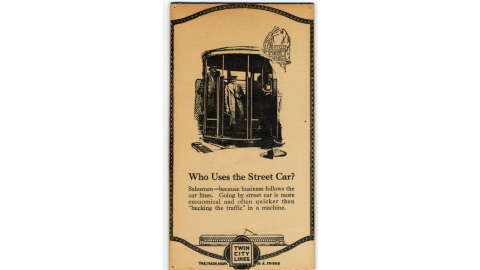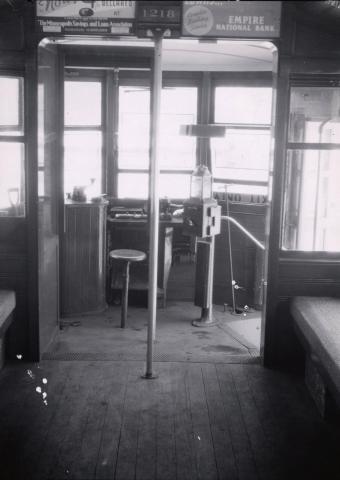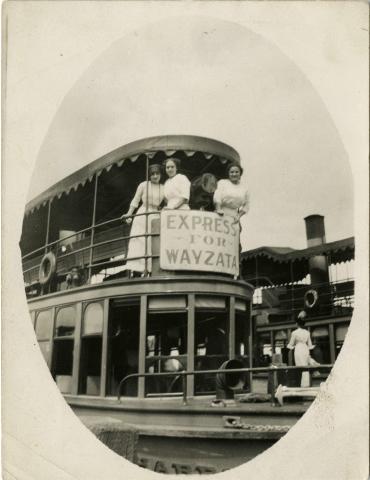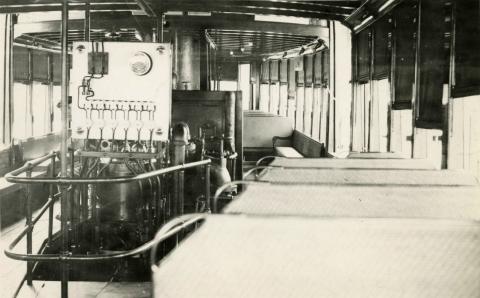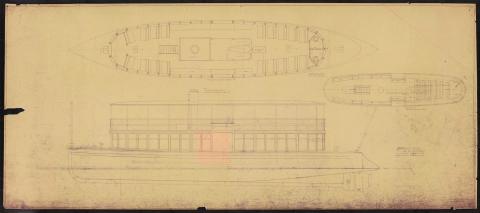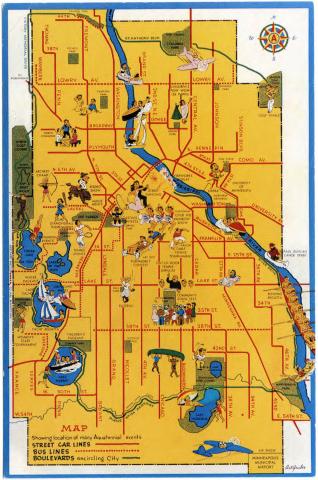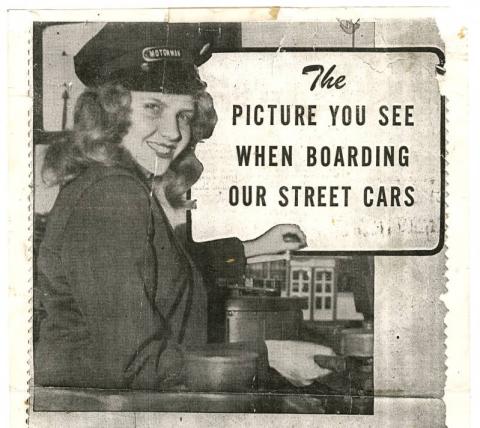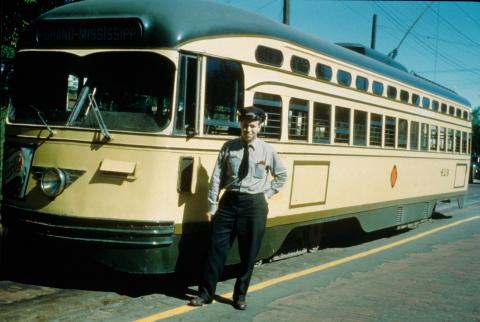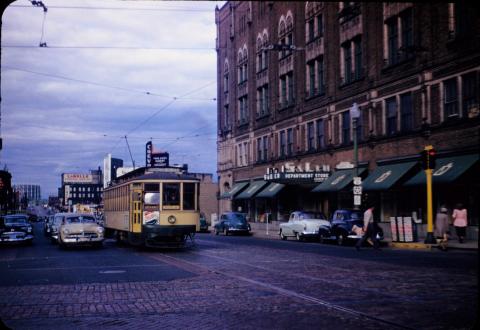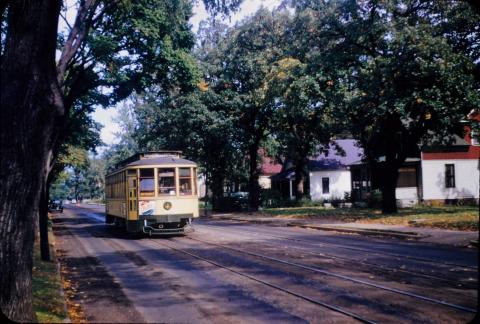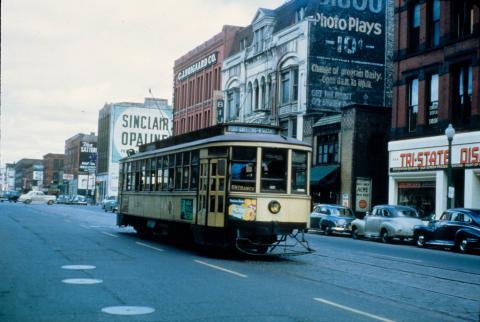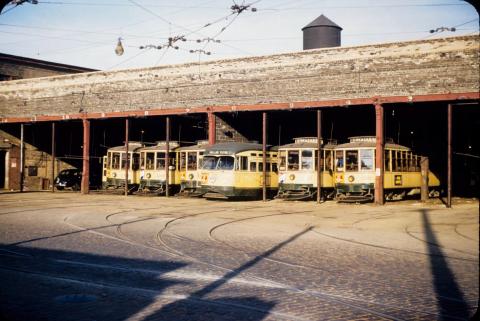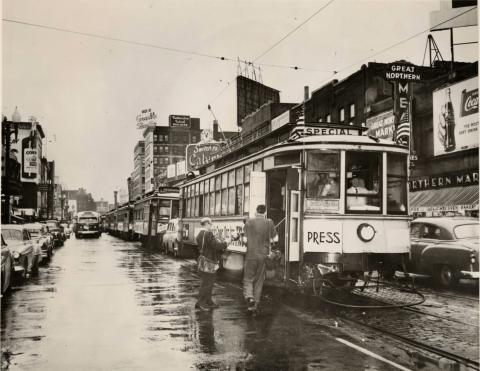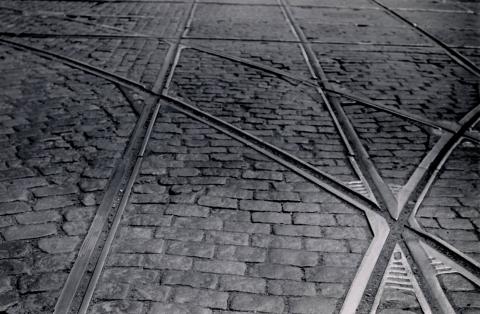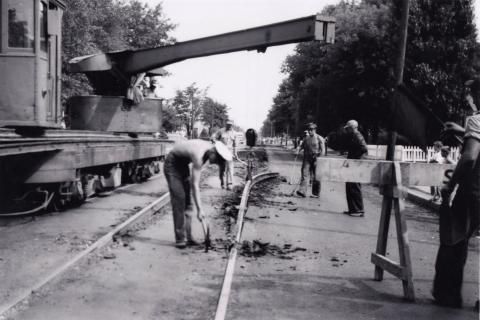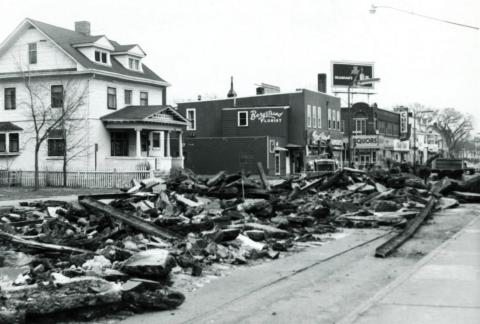Primary Source Set
by Kathleen Huynh, Resource Sharing Specialist - Campus Locations, Minitex
Business and Industry Transportation
Horse cars were the first public transit system in the Twin Cities. In 1872, the St. Paul Street Rail Company began running horse-drawn cars in St. Paul. Three years later, the Minneapolis Street Rail Company began running their own horse-drawn car lines in Minneapolis. Horse car lines were expensive to operate and the odor and health risks posed from the horse manure were a real concern. Both cities began looking to update their transit systems in the 1880s.
Minneapolis and St. Paul started investing in cable or electric street cars. The St. Paul Street Rail Company began running the first cable car line in 1888, with a second line opening a year later. In 1889, the Minneapolis Street Rail Company purchased material to build six cable car lines, but the lines were never built. That same year, the Minneapolis City Council passed a resolution to convert Fourth Avenue's horse car line into an electric line. The line was such a success that the Minneapolis company decided to build the electric car lines rather than the cable car lines.
In 1891, Thomas Lowry, who controlled both the Minneapolis and St. Paul Street Rail Companies merged the two creating the Twin City Rapid Transit Company (TCRT). The company successfully converted all horse car lines in Minneapolis and St. Paul and the two cable car lines in St. Paul, to electric car lines. The company continued to build new lines at a steady rate. This electric car system became one of the finest public transportation systems in the nation.
At its height in the early 1920s, the TCRT operated more than 900 streetcars, had 523 miles of track in the Twin Cities and surrounding metro, and carried over 200 million passengers a year. The company even had a fleet of steamboats, called Express Boats, that crossed Lake Minnetonka and connected passengers with streetcars. The Express Boats operated from 1906 to 1926. The company, for a brief time, even owned the Big Island Amusement Park and Lake Park Hotel on Lake Minnetonka, and the Wildwood Amusement Park on White Bear Lake.
Their downturn began shortly after their peak with the mass production of automobiles in the 1920s. Ridership fell 48 percent from 1920 to 1932. The Great Depression worked for and against the company. Several lines had to close including the long suburban lines to Lake Minnetonka, White Bear Lake, Stillwater and Anoka, as well as a few city routes. On the plus side for the company, the Depression stopped suburban development and automobiles were neither affordable nor available.
A surge of riders occurred during WWII due to tire and gas rations, and women began to be hired as "motorettes" to replace the motormen called to military service. This surge continued until the early 1950s. Automobiles were on the rise again along with suburbanization. People were moving out to the suburbs and the vehicle became the easiest way to get around. Along with that, new management took over the company in 1949. They began replacing streetcar lines with buses, which were cheaper to operate. The last streetcar made a final ceremonial run in Minneapolis on June 19, 1954.
Discussion Questions & Activities
- Before streetcars, it was difficult to get around the Twin Cities. What are some ways having a streetcar system in a metropolitan area benefit the city, local business, and its citizens?
- Based on the items in this set, what are some similarities and differences between the Twin Cities old streetcar lines and the current Metro Transit system in the Twin Cities?
- Why do you think there was such a strong appeal to move out of the city when cars became more available and affordable in the 1950s?
- The set includes a couple images of tracks being removed from the streets to make more room for cars. What are the disadvantages of removing a robust transit system from a city?
- The set includes a couple of advertisements explaining the benefits of riding streetcars. Can you think of other benefits from riding public transportation?
- What would it be like to be a streetcar driver in the early 1900s in the Twin Cities? Would it be an easy job or hard job? What would it be like to operate a streetcar in the hot summers and cold winters in Minnesota?
- Map out an imaginary city and create a transit system. Keep in mind what areas and locations should be along the transit line (grocery stores, schools, hospitals, etc.). Also think where and how frequent stops should be.
- Create a transit system in your own neighborhood/town/city. Think where and how frequent transit stops should be. Are there locations in your neighborhood where it would be convenient to have a transit line stop?
- This set includes streetcar design drawings. Design and draw your own streetcar. Think how big the streetcar should be, how many seats and windows there should be, the maximum number of passengers that could fit, how many exits and entrances there should be, and other features the streetcar should have.
eLibrary Minnesota Resources (for Minnesota residents)
Lileks, James. "Minnesota Moment: St. Paul and Minneapolis Joined by Electric Streetcar." TCA Regional News, Dec 07, 2018. ProQuest.
"Streetcar." Britannica Academic, Encyclopædia Britannica, 29 Oct. 2018. Web. Accessed 20 May 2020.
Twin Cities by Trolley. U of Minnesota, 2007. BiblioBoard. Web. 27 Apr. 2020.
Woltman, Nick. "Long before Green Line, St. Paul's Rail Transit had Hooves." Saint Paul Pioneer Press, Jul 14, 2015. ProQuest.
Additional Resources for Research
Anderson, Matt. "Streetcars in St. Paul and Minneapolis | Museum Collections Up Close". Minnesota Historical Society, 2008. Web. Accessed May 21, 2020.
"A Brief History of Twin Cities Transit." Minnesota Streetcar Museum. Web. Accessed May 21, 2020.
Cameron, Linda A. "Cable Cars of the Minneapolis and St. Paul Street Railway Companies." MNopedia, Minnesota Historical Society. Web. Accessed May 21, 2020.
Cameron, Linda A. "Horsecars of the St. Paul and Minneapolis Street Railway Companies." MNopedia, Minnesota Historical Society. Web. Accessed May 21, 2020.
Cameron, Linda A. "Twin City Rapid Transit Company and Electric Streetcars." MNopedia, Minnesota Historical Society. Web. Accessed May 21, 2020.
Diers, John W. The Rise and Fall of TCRT’s Snelling Shops : from Streetcars to Soccer. 2018.
Lowry, Goodrich. Streetcar Man : Tom Lowry and the Twin City Rapid Transit Company. Lerner Publications, Co., 1979.
Ogland, James W. "Picturing Lake Minnetonka. Selections." Minnesota History, Vol. 57, No. 6, Summer 2001, pp. 296-304.
Olson, Russell L. The Electric Railways of Minnesota. Minnesota Transportation Museum, 1976.
Xie, Feng, and David Levinson. “How Streetcars Shaped Suburbanization: a Granger Causality Analysis of Land Use and Transit in the Twin Cities.” Journal of Economic Geography, vol. 10, no. 3, 2010, pp. 453–470. Accessed May 21, 2020.
Published on
Last Updated on
